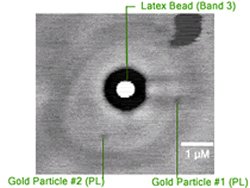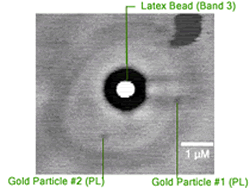Studying
Cell Biology
Preface |
Introduction to Problem Solving | Problem
Sets | Acknowledgments
|
A.8.f. <<Previous Problem Next Problem>>
|
Print
PDF
|
| <PREVIOUS PART |
| NEXT PART> |
| INTRODUCTION |
| A |
| B |
| C |
| D |
| E |
| F |
|
8.F. The data collected by Tomishige, et al., and presented in this problem set, strongly suggest an association between Band 3 protein and spectrin and the existence of two populations of Band 3 protein, based on the nature of that association: 1. those tethered to spectrin and 2. those untethered or “free”, but constrained in their diffusion to the interstices of the spectrin network. The Tomishige model is presented in the cartoon to the right, which illustrates a three dimensional view of the RBC membrane including both types of of Band 3 protein and the spectrin cytoskeleton; a gold particle is attached by a monovalent antibody to an untethered Band 3 molecule. How does this model compare with the one you developed as you interpreted the results of the various experiments? |
 |
|
Clearly, however, the methods used to obtain these high resolution data – ghost preparation, the various antibody reactions and application of a laser force field – could also have modified the hydraulic and structural properties of the membrane. To examine this possibility, a Control experiment was run in which gold was attached to a phospholipid component of the membrane (specifically to phosphatidylethanolamine) and the experiment described in 8.E. was repeated. As before, the latex bead was attached to several Band 3 proteins, which in turn were tethered to the underlying spectrin cytoskeleton. The data are presented in the following video, which is also divided into three episodes; the movements are “real-time”. First, watch and describe the behavior of gold particle #1 as the optical tweezer moves the bead from right to left and back; then consider the behavior of gold particle #2. How do their behavior affect your perception of membrane fluidity? For more information concerning this problem set, consult the video review by Michio Tomishige and Akihiro Kusumi (1999, Mol Biol Cell 10: 2475-2479. PMID:10436005). |
|
|
QUESTIONS 1. Describe the behavior of tagged PL molecule #1 during the first and last episodes and compare this behavior with that exhibited by the tagged Band 3 protein in the last experiment. 2. How is PL behavior affected by displacement of the membrane
cytoskeleton, using the optical tweezer to move the latex bead,
during episodes 2 or 3? 3. Does PL #2 behave in the same manner as PL #1. Explain any differences in their behaviors. |
|
